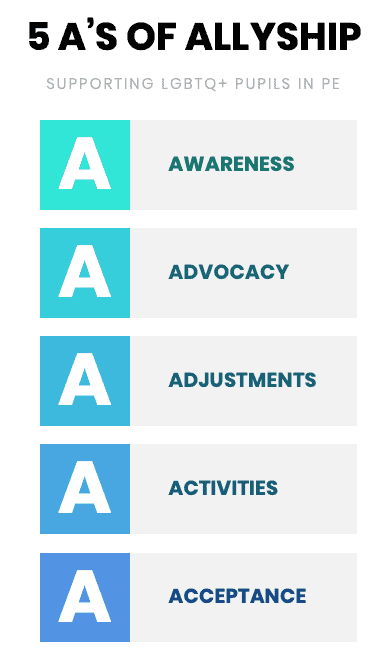
At the end of January, Gareth Evans highlighted in his article for Schools Week that Physical Education (PE) is currently failing to meet the needs of most pupils. In this article, we continue the conversation by offering our thoughts on how PE can be a safer and more inclusive space for all children.
Traditionally, PE has been a polarising subject. The subject we love or loathe, enjoy or hate, look forward to, or avoid at all costs. Yet physical activity is so important for everyone. So how can we address these polarised perspectives and ensure we reach and inspire all pupils? For a long time physical education and sport have been synonymous, with competitive sport dominating the PE curriculum. This has perhaps been one of the problems. Now don’t get us wrong, we are not anti sport or healthy competition, but we do believe that they shouldn’t be prioritised over and above an inclusive and meaningful curriculum. So if PE isn’t just about teaching sport techniques, what should it be about?
We believe that we all should be working towards an impactful, socially just and inclusive PE experience, that places the pupils at the centre of the curriculum, with a co-constructed and rich menu of meaningful physical activity experiences on offer. And when we say placing pupils at the centre of the curriculum, we do mean ALL pupils.
Part of providing a meaningful PE offer for ALL pupils is being proactive and effective in identifying, addressing, raising awareness and closing inequalities. All teachers need to champion inclusive practice, especially in supporting pupils with protected characteristics (age, disability, gender reassignment, pregnancy and maternity, race, religion or belief, sex and sexual orientation). The Equality Act requires all public bodies, including schools to take active steps to eliminate discrimination, reduce in-equality, promote equity and strive for social justice. This includes having due regard for the need to:
- remove or minimise disadvantage associated with a protected characteristic;
- meet the needs of individuals who share a protected characteristic;
- encouraging those who share a protected characteristic to participate especially where participation by that group of people is disproportionately low.
The PE profession certainly has much more work to do in addressing the above. And while some protected characteristics have robust guidance such as the Special Educational Needs and Disability (SEND) code of practice for 0-25 year olds, others are yet to provide support for how best to support pupils.
One area in need of further guidance is how to support transgender and gender diverse pupils in PE. Pupils who identify as transgender may define themselves as transexual, intersex, gender dyshopric or feel that they do not fit into the gender that society expects of them. Gender fluid or non-binary are also terms that pupils might use to describe how their gender may not be exclusively categorised as male or female. There are also pupils who might just be questioning their gender identity and their gender expression, which is a completely normal part of making sense of your own identity.
What does this look like in PE practice? Firstly, it is important to stress that making changes toward achieving a more inclusive offer does not have to mean that provision is compromised for pupils. The opposite is true. A fairer and more just provision can support all pupils, regardless of their background and experience, in developing compassion and consideration for others, and in embracing difference and diversity.
So now imagine and put yourself in the shoes of a pupil who might be questioning their identity or consider themselves as trans, who has PE on their timetable today. Do they look forward to, or worry about this lesson? PE can be quite confronting to pupils who are not cisgender because of the binary gendered traditions of our subject. For example boys and girls; changing rooms, PE kit, groups and activities. Here are our top tips or our 5 A’s in becoming an Ally to the LGBTQ+ community in PE.
 Awareness about LGBTQ+ is very important. Understanding the LGBTQ+ community and their lives and experiences, and being knowledgeable and educated on the issues, facts, laws, policies and culture of the LGBTQ+ community will help the PE profession create more inclusive and culturally inclusive environments.
Awareness about LGBTQ+ is very important. Understanding the LGBTQ+ community and their lives and experiences, and being knowledgeable and educated on the issues, facts, laws, policies and culture of the LGBTQ+ community will help the PE profession create more inclusive and culturally inclusive environments.- Advocacy or in other words being visibly seen as a safe person and place for pupils to be who they are without judgement. This includes a zero tolerance on homophobic / bi-phobic / transphobic language or gender shaming for example recognising that comments such as ‘you throw like a girl’ are unacceptable.
- Adjustments to our language and environments can be made so that we are more inclusive and less binary. For example, we can reduce or eliminate gendered language substituting terms such as ‘ladies and gents or girls and boys’ to more neutral terms such as year 7, class, pupils, students, folks, peeps and people. We advise with regards to our environment, renaming boys and girls changing rooms to changing rooms 1 and 2 and having somewhere suitable for those who do not feel comfortable in either setting to change into their PE kit. Also PE kits can be adapted to be gender neutral for example guidance such as skorts/leggings/tracksuit for the girls and shorts/tracksuit for the boys, should be avoided, they are just items of clothes and pupils can choose to wear what they feel most comfortable in.
- Activities should also be gender neutral, avoiding stipulations that girls partake in netball and hockey, while boys partake in rugby and football. Activities are just that, not activities for boys and activities for girls. This also extends to extracurricular clubs and wider opportunities whereby all students should be able to attend, regardless of their gender. There are some complexities around this e.g. some groups of pupils may want to participate in single gender groups such as a girls football club. However, there must be an opportunity for all students to access all activities, so a combination of both single and mixed groups may be appropriate.
- Acceptance of all pupils and who they are is so important. Acceptance is the extent to which the LGBTQ+ community or anyone for that matter are seen in ways that are positive and inclusive. All young people have faced adversity and challenge over the last two years; with unprecedented disruption to their education and restrictions on their social opportunities. Therefore, compassion, empathy and acceptance is key to supporting our young people. Transgender and gender fluid pupils need compassion and support as much as any minority group, or indeed any individual and thus feeling accepted for who you are is so important. Being socially and publicly accepted for who you are is tremendously powerful. It highlights that this environment is a safe place for you to be who you are.
We are really passionate about ensuring that PE stands for “Positive Experiences’ for ALL pupils. We have an opportunity and a responsibility to ensure that ALL pupils find their passion for physical activity in a safe, supportive and inclusive environment.
About the Authors
Simon Scarborough (he, him, his) – @leading_in_Ed
Simon is Head of Physical Education at Crispin School in Street, Somerset. He is also a Youth Sports Trust, PE Catalyst and has School Senior Leadership experience in supporting vulnerable student groups.
Dr Liz Durden-Myers (she, her, hers) – @LizDurdenMyers
Liz is a Senior Lecturer in Physical Education at Bath Spa University and the University of Gloucestershire. Liz is also a co-founder of PE Scholar.


Responses